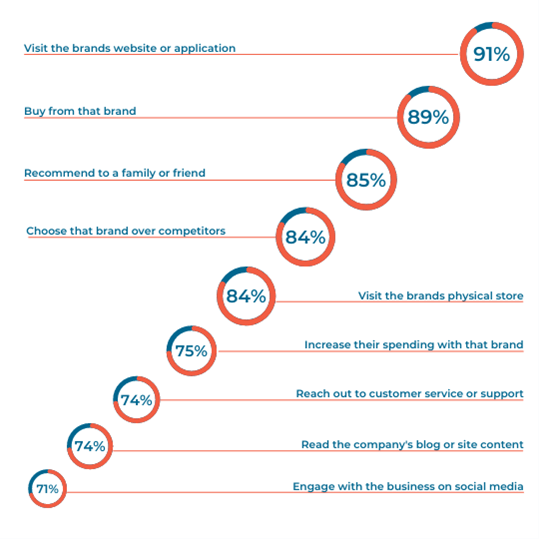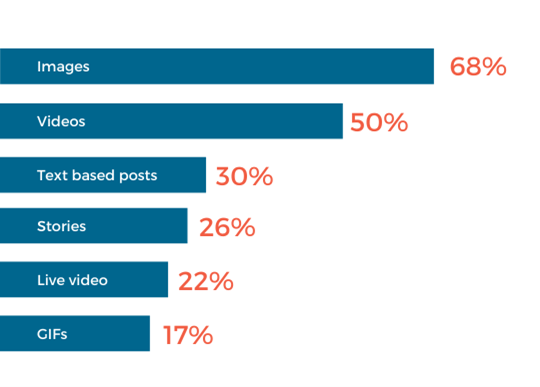For businesses maintaining a presence, social media is a no-brainer. Brands that invest in social media marketing benefit from increased sales and stronger customer loyalty over their competition. When consumers follow a brand on social media platforms, research demonstrates that 89% will buy from that brand and 75% of consumers will increase their spending with that brand.
As more and more businesses recognise the importance of digital marketing, the social landscape is reaching a saturation point. This presents a unique challenge to generate visibility to the right people at the right time.
Consumer benefits from following brands on social media
Why consumers unfollow brands on social media
Align your social media goals with your companies
Setting goals within silos inhibits social media from visibly influencing an organisations goals and demonstrating its value to the entire company. Establish time to discuss these goals with management to identify how social media can support other teams and what insights marketers can share to implement the most significant impact.
Primary goals for social media include:
- Increasing brand awareness
- Boosting web traffic
- Growing the brand’s audience
- Promoting content
- Increasing community and engagement
- Driving sales
- Connecting with target audience
- Providing customers service and support
- Track and understand competitors.
Understanding your audience is the first step to creating a social media strategy
Appropriately determine your buyer personas and audience to target their needs and interests. By considering your audience, this will enable you to establish what content will attract the type of customers you hope to gain and how to create engaging content to maintain their interest.
Renowned author Gary Vaynerchuk says,
“The key to social media marketing success isn’t about pushing out a lot of content – it’s about pushing out specific content tailored towards your target audience and using the right platform to do so”.
Identify where your target audience spends their time
It’s essential to understand where your audience is today and where they may be tomorrow. In the table below, we have identified the different social media platforms available to businesses, the users they attract and how to leverage them.
|
|
Users: 1.79 billion daily active users worldwide
Audience: Generation X and millennials Industry impact: B2C Best for: Brand awareness and advertising |
|
|
Users: 186 million daily active users worldwide
Audience: Primarily millennials Industry impact: B2B and B2C Best for: Public relations and customer service |
|
|
Users: 1 billion monthly active users
Audience: Primarily millennials Industry impact: B2C Best for: Brand awareness, user generated content, advertising |
|
|
Users: 675 million monthly active users worldwide
Audience: Baby boomers, Generation X, and millennials Industry impact: B2B Best for: B2B relationships, business development, and employment marketing |
YouTube |
Users: 249 million daily active users worldwide
Audience: Millennials and Generation Z Industry impact: B2C Best for: Brand awareness and advertising |
Snapchat |
Users: 249 million daily active users worldwide
Audience: Primarily Generation Z Industry impact: B2C Best for: Brand awareness and advertising |
|
|
Users: 416 million monthly active users worldwide
Audience: Primarily older millennials and younger baby boomers Industry impact: B2C Best for: Visual advertising; inspiration |
Creativity differentiates between good social media performance and excellent performance with strong ROI
Growing your social following supports business’ revenue goals, however, to attract new followers’ marketers need an understanding of what types of content will engage (and disengage) their customers.
Consumers believe a brand’s social media presence stands out from competition when its creative, memorable and impactful. Below we have identified the different types of content consumers engage with:
An in-depth understanding of your audience and what captures their interest can create a powerful social media campaign.
Generating buzz and excitement on Twitter is how Wendy’s promoted its new breakfast menu offering. The fast-food brand, known for its snarky comebacks, went “private” with its Twitter account and offered a coupon where only its existing followers could acquire.
Wendy’s leveraged its 3.6 million followers to further generate hype by roasting competitors with #WendysBreakfastBattle and posting the most popular tweets on a billboard in New York’s Times Square. The stunt resulted in more than 10,000 follower requests within 36 hours.
Whilst most businesses aren’t operating with Wendy’s resources, they can learn from this campaign the power of turning your fans into brand advocates. Leverage your social media following to spread the word regarding new product launches through user-generated content and make it easy – and appealing – for fans to share your brand content on their social feeds.
Strategic social media trends
- Increase use of video content – Both long-form and short-form videos are among the most shared social media content. Audiences want to hear from your business and consume content in a more entertaining way.
- Emphasis on brand voice and authenticity – Consumers are gravitating towards businesses whose values align with their own.
- Useful content vs engaging content – Businesses have shifted from providing useful content to engaging content. It’s no longer enough to provide your audience with useful content, it’s about creating content that captures their attention and maintains this engagement.
- The importance of listening –Staying in tune with your audience enables you to better connect through the right conversations. Businesses should also listen to how their audience reacts to content.
Compare performance with your competitors
Businesses should evaluate if they’re keeping pace with their industry standards. Certain industries are likely to receive a higher volume of engagement than others. Our table below highlights the difference in industry performance.
Average inbound engagements
|
Average engagement per posts |
|
| 270 | 38 | |
| |
64 | 6 |
| 75 | 10 | |
| 98 | 16 | |
| 78 | 14 | |
| 306 | 30 | |
| 1123 | 28 | |
| 276 | 19 | |
| 41 | 6 | |
| 60 | 19 | |
| 256 | 36 | |
| 357 | 25 | |
| 975 | 29 | |
| 101 | 14 |
The importance of social media metrics and why they should be tracked
Social media metrics are critical to measure success of a particular campaign, how well your social strategy is performing and ultimately the impact on your overall business performance.
Every social media platform has its native analytics. We recommend using a social media analytics tool to minimise time pulling metrics from all sources and manually creating reports.
We have identified essential social media metrics for tracking progress:
| Types of metrics available | How to use them |
| Likes, comments, shares, and clicks | The best indicator of engagement. Businesses can see how actively involved with your content your audience is and how your brand campaigns are performing |
| Impressions and reach | An essential metric if your goals are focused around brand awareness and perception |
| Volume and sentiment | Share of voice is a metric often used in public relations or as part of competitive analysis or paid advertising campaign. It indicates how much of the online sphere your brand is capturing |
| Referrals and conversions | Social referral traffic and conversions are tied to sales and marketing goals, and ultimately primary business goals |
| Response rate and time | This metric tracks how fast your team responds to important messages and how many of them are being responded to. Ultimately, impacting your customer’s experience and audience goals. |
Would you like to be a part of this?
Become an integral Member of a confidential group of business owners sharing their insights and experiences for the benefit of your business? Imagine how your business would prosper from connecting with a broader community consisting of more than 400 high performing and driven industry leaders!
Explore Membership today! Find out how our proven program can assist you build a better business and become a better leader.




